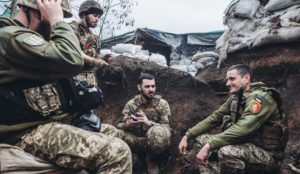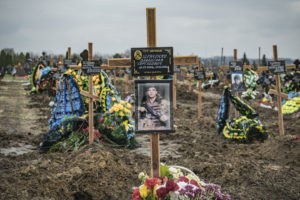Kharkiv, Ukraine
“I will not talk to anyone who calls this war a ‘conflict’! Bye!” The angry response surprises me. I’m typing a message on Facebook chat while I dash through a street in Odessa, buying last minute supplies for my trip to Ukraine’s second city, Kharkiv. A mutual friend has told me to get in touch with a contact she knows there. “Hi, Nataliya,” I type. “I’m interested in covering the work you’re doing documenting Russian war crimes in this conflict.”
Thus I am introduced to Nataliya Zubar, amateur painter, knife aficionado, Ukrainian patriot, and fearless monitor of Russian war crimes in her home city of Kharkiv. When this war is finally over, it is the work of people such as Nataliya that will ensure Ukraine is able to settle its accounts.
She continues: “I am very picky about who I talk to. I sent to hell CNN and lots of other media organisations who have asked for my help.” After some back and forth, she accepts my apology for the unthinking slip, and we decide to meet in Kharkiv. As I go to log off, she sends me a final message, clearly keen to ensure I don’t make another faux pas: “Here is a huge chunk of Ukrainian text all about me.”
I scan through it. It is indeed comprehensive, detailing a life of activism in the service of Ukraine. Later on, when we speak, she explains her problem with the word “conflict”. It was, she says, used instead of war for the past eight years. “It undermines the gravity [of the situation in Ukraine]. Every war is a conflict, but not every conflict is a war. “
She continues: “Once, some foreign researchers edited my testimonies and replaced war with conflict.” She pauses. “Fucking people.”
***
Sometimes, at night, I fall asleep and dream about being blown up. It is, I think, a legacy of all the shelling I’ve heard. For some reason, it’s always my fingers that feature. I feel the blast tearing them from my hands. I feel the base of the joints tingle. I think it’s because I use them to write; I associate them with my identity.
If you want to see the effects of bombing, go to Kharkiv. “We call this ‘the city of broken windows’,” says Nataliya as we drive through the centre of the city, with her colleague Oleksiy and the journalist Jen Stout. The city usually has a population of around 1.5 million people but right now its central streets are pretty much deserted. Shops and restaurants are boarded up. I’ve already been told it will be tough to find a working ATM.
Bombs have ravaged the cityscape; buildings have chunks missing from them. One block on the corner of Moscow Prospekt and Constitution Square looks like a row of crumbling teeth: depleted and riddled with gaps. Where buildings haven’t been directly hit, shockwaves from the bombs have smashed windows of those nearby.
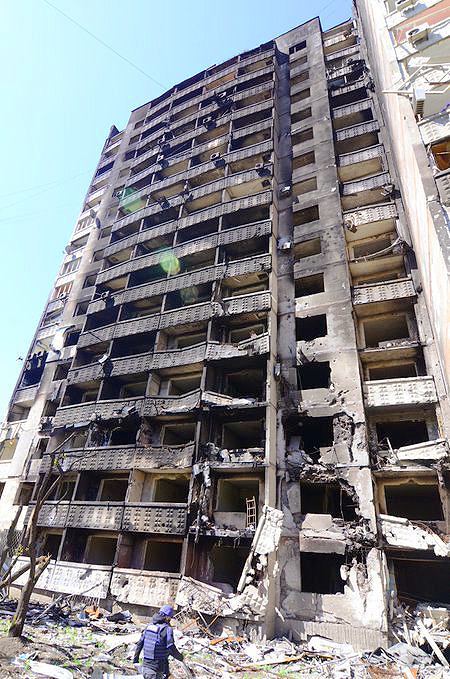
The Battle of Kharkiv began on the first day of the war. The city is just on the Russian border, where, on 24 February, Russian forces crossed from Belgorod. They clashed with the Ukrainians, before fighting moved to the northern suburbs. Then they started bombing.
In the early days, many thought the city had fallen. “Those clowns sent text messages to everyone saying we had surrendered, and I got loads of messages telling me to flee,” Nataliya snorts.
The Russians used planes to pound the city. As well as damage, they sought to use what Nataliya calls “acoustic terror” — forcing people to flee due to the relentless thunder of their bombing. According to Hanna Shelest, Director of Security Programmes at Ukrainian Prism, the Russians were always going to go hard for Kharkiv. “Obviously it’s a centre of industry, but more than this it controls the access to Luhansk. Take Kharkiv and you control the whole East,” she says.
Nataliya tells me how she started documenting Russian bombing. It was late evening on 9 March, and she was in her house during yet another air raid. People had been telling her to use the bomb shelters during the air raids, but she ignored them. The Russians weren’t going to drive her underground. As far as she was concerned, they could just fuck off.
But then two rockets hit the shopping mall just 120 metres from her house. The blast was immense. Her world shook. “What the fuck am I doing in here?” she thought to herself. “I need to get out there and help.” And she did.
“From day one, we focused on documenting Russian crimes within the proper Ukrainian criminal procedures. What we do is take photos and videos of destruction to civilian infrastructure. The office of the Prosecutor General of Ukraine formally opens criminal proceedings and they delegate the right to conduct the investigation to the Ukrainian security services, which then reach out to citizens to help them to collect their evidence. This is where we come in.”
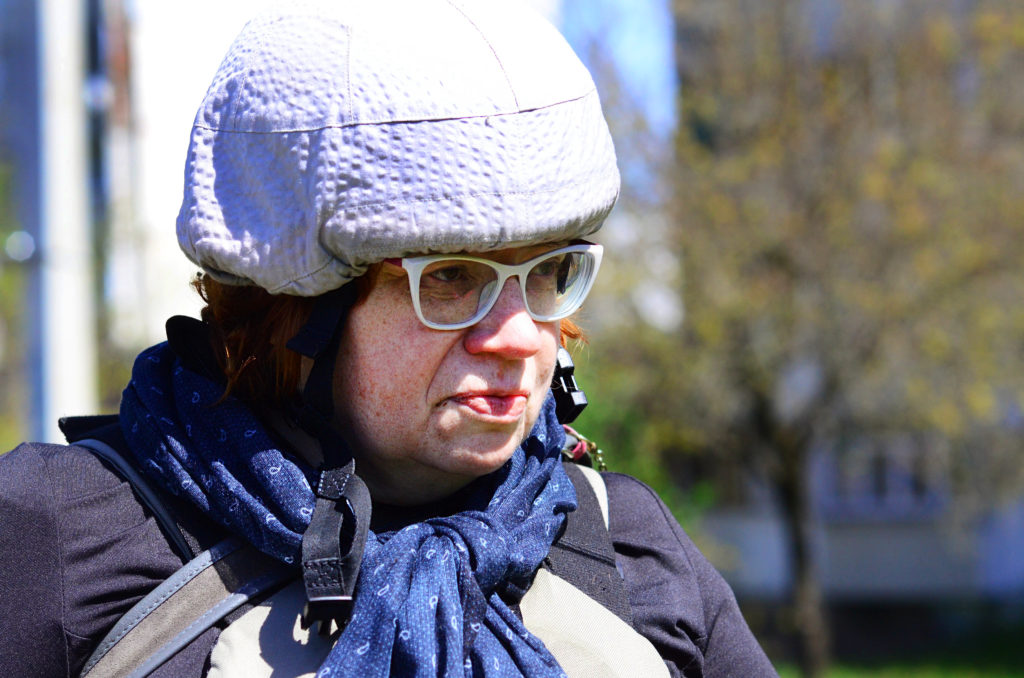
The day after the bombing, Nataliya shot her first video. Now she is taking me through the worst of the damage. On the morning of 1 March, a Russian 3M54-1 Kalibr missile struck the Kharkiv Oblast Administrative Building in Freedom Square. The building’s structure still stands, but inside it’s been devastated. I step through the ruins. The ground has become a vista of undulating grey rubble: it’s like being on the moon. Beneath this lies an array of detritus from civilian life: cups, plates, coffee pots and cutlery — everyday life smothered by violence. I look up: the floors have collapsed, and I can see straight up through the building to the sky. Nothing says industrial warfare like death dropped from hundreds of feet in the air.
Nataliya explains the tactics behind Russian bombing. They target three things. First, administration centres to stop the effective running of the city. Then it’s communications. We drive to a residential block that looms over a large hole in the ground, beneath which I can see a series of thick cables and wires. It’s as if someone has lifted up a flap of the city’s skin to reveal the veins and arteries beneath. “Electricity and internet cables,” she explains.
The third thing Russia targets are emergency services. As we pass by yet more destruction, I remark that I was recently in Mykolaiv and was shocked by how large the bomb craters there were. “Ours are bigger!” snaps Nataliya.
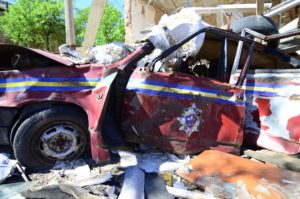
Nataliya wants me to see a final bombsite before we get out to the frontlines in the areas beyond central Kharkiv. We pull up at a State Emergency Services station. It’s carnage. The building is in ruins; in what I assume was once a courtyard sits a crater so large that the remains of several cars lie in it. Nataliya looks around. “Belgorod is just 40km away,” she says. “This sort of stuff will always be a threat until we demilitarise Russia, or at least a part of it,” she says thoughtfully.
“Is that really plausible?” I reply.
“Believe me, there are a lot of people here who want to give it a go.”
***
“Welcome to hell,” says Nataliya with a broad grin. It’s about two hours later and we are entering Saltivka, a large residential area located in Kharkiv’s northeastern region, where the fighting is relentless. She is wearing a white helmet and has also put on a compass wristwatch. Most of the shelling is coming from the north, she explains, so we need to navigate accordingly. We pass through a succession of empty checkpoints. “Hmmm.” Nataliya pauses. “If they’re empty, it means they’re probably taking cover from shelling.”
If Saltivka is hell then the northern part of it is its ninth circle. Here, the Russians are shelling from two sides, while Russia is just over 20km away. The sound of artillery is, if not constant, frequent. It’s both ingoing and outgoing — they are fighting as we walk.
I stop outside a ruined building, black smoke still billowing from its windows. Suddenly, I hear a scratching sound and from beneath a concrete slab emerges a kitten. It scampers over to its mother and siblings. Cats are a constant feature of bombed-out ruins on the frontlines. Unlike dogs, which are too nervous, they don’t mind the sound of shelling. “You never see a thin cat in a warzone,” says Nataliya. Later, we pass a dead pigeon on the road. “They, on the other hand, just drop dead. Their hearts literally burst from the roar of the shelling,” she explains with mild contempt. “It’s why they had to stop using carrier pigeons in the First World War.”
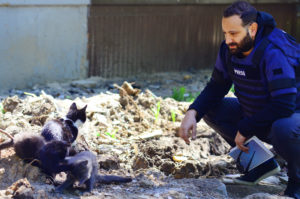
Almost everyone has fled North Saltivka, though a few have chosen to remain. I speak to a blonde lady who refuses to leave her cats. She spends most of her life in a bunker in the basement of her apartment block. She takes me through a dank maze of rooms, one of which still contains a huge Soviet-era map spread across the wall. As we leave, Nataliya tells me that the lady complained the cat food she has is of terrible quality. “I’ll try to bring her some better stuff next time,” she says.
Later, in a gazebo on a patch of green outside an apartment block, a safe distance back from the front, I meet with Nataliya’s friend Vitaliy, who runs a volunteer organisation raising money to buy necessities for civilians and the army. I ask him how feels about all this — gesturing around us. He’s phlegmatic. “Every Ukrainian born in the last 100 years has had to fight for their freedom,” he says.
All the while, Nataliya is filming things with her phone on the end of what looks like a yellow selfie stick.
“That looks heavy, Nataliya,” I say jokingly.
“Yes, it is. I could kill you with it, actually.”
***
Later that day, I sit in a cafe while Nataliya tells me more about her history. I joke about her ability to kill me with her selfie stick. “Yes, and I also have a knife,” she says, producing a colossal steel blade from her handbag.” I laugh. “It’s a Finnish knife,” she says indignantly.
The day’s work finishes, and I go with Nataliya to her house where we sit in her living room, drinking tea served by her husband. “Here is a painting that I am doing about the war,” Nataliya says, pointing to a small canvas sitting on an easel. I see vigorous brushstrokes in bright colours: it is vivid and energetic, with an almost childlike quality of simple honesty. It is just like Nataliya.
“Lovely,” I say. “It’s not lovely yet,” she retorts. “We haven’t won yet.”
I leave and make my way back to my hotel. My thoughts drift to earlier in the day, when Nataliya’s colleague Oleksiy had pulled a steel Ukrainian Trident — the country’s national symbol, the Tryzub — from the rubble of the emergency services station bombsite. I lie on my bed and, once again, I drift in and out of sleep. I start to dream once more and I see Oleksiy holding it out in front of me. “Look,” he says with a grin. “Ukraine rises again.”
***
Watch David in Saltivka here:
Disclaimer
Some of the posts we share are controversial and we do not necessarily agree with them in the whole extend. Sometimes we agree with the content or part of it but we do not agree with the narration or language. Nevertheless we find them somehow interesting, valuable and/or informative or we share them, because we strongly believe in freedom of speech, free press and journalism. We strongly encourage you to have a critical approach to all the content, do your own research and analysis to build your own opinion.
We would be glad to have your feedback.
Source: UnHerd Read the original article here: https://unherd.com

